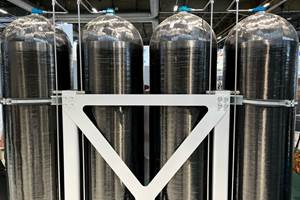SPE ACCE 2014 best paper winners announced
Two papers in the Virtual Prototyping & Testing of Composites session, and one in the Nanocomposites session, have been judged the best at this year's SPE Automotive Composites Conference and Exhibition, Sept. 9-11 in Novi, Mich., USA.
The organizing committee for the Society of Plastics Engineers (SPE, Troy, Mich., USA) Automotive Composites Conference & Exhibition (ACCE) has announced the Dr. Jackie Rehkopf Best Paper Award winners for the group’s 14th-annual show, Sept. 9-11 in Novi, Mich., USA.
Three winners – two speaking in the Virtual Prototyping & Testing of Composites technical session and one in the Nanocomposites session – who received the highest average ratings by conference peer reviewers out of a field of 83 contenders will be honored for excellence in technical writing during opening ceremonies. Honorees Maxime Melchior, software development engineer at e-Xstream engineering, an MSC Co., took first place in this year's competition, while Sylvain Calmels, business development manager - automotive at e-Xstream engineering and Keith Honaker, graduate student at Michigan State University and a 2013-2014 SPE ACCE graduate scholarship award winner, were tied for second place.
The conference's best paper awards have been renamed in honor of long-time SPE ACCE committee member, session organizer, two-times technical program co-chair and long-time automotive composites industry researcher, Dr. Jackie Rehkopf, who died of cancer this summer.
Dr. Maxime A. Melchior was lead author (along with Marc Duflot, Jean-Sébastien Gerard, Laurent Adam, and Roger Assaker all from e-Xstream engineering) on a paper entitled, "End-to-End FE-based Homogenization of Woven Composites," which will be presented by e-Xstream colleague Dustin Souza. About his topic, Melchior explains that woven composites are represented by interlacing yarns impregnated by a resin matrix. Yarns are made of a resin matrix reinforced by continuous fibers. Homogenization of woven composites therefore requires two levels of homogenization: one for the yarn and another for the ply. Finite element (FE)-based homogenization at the ply level can be combined with mean-field homogenization at the yarn level to predict the mechanical behavior of a single ply. The main difficulty of this approach lies in the generation of a representative volume element (RVE) for a single ply. An end-to-end FE-based homogenization of woven composites has now been developed. A fully analytical framework based on mean-field homogenization also has been developed and this framework takes yarn curvature into account. The paper describes the newly developed tools, and the FE-based and mean-field homogenization predictions of linear properties are compared to experimental measurements on plain weave and 5HS woven composites.
Sylvain Calmels was co-author with Benoît Bidaine, also from e-Xstream engineering of a paper entitled, "Progressive Failure of CFRP Coupons and Automotive Parts," which will be presented by e-Xstream colleague Kurt Danielson. This paper addresses the application of a multi-scale material-modeling strategy to the specific needs of post-failure behavior simulation of continuous-fiber composite parts submitted to dynamic loads. The work demonstrates how simulation can be improved, for automotive safety design simulations in particular, helping to reduce design delays, cost, and weight of such structures.
Keith Honaker was lead author (along with Frédéric Vautard and Lawrence T. Drzal, also of the Composite Materials and Structures Center at Michigan State University as well as Lang Sui of the Hyundai-Kia America Technical Center Inc.) on a paper entitled, "Processing Methods of High Density Polyethylene-Exfoliated Graphene Nanoplatelet Nanocomposites for Automotive Fuel Tank Applications," which Honaker will present. About his topic, Honaker explains that the paper discusses high-density polyethylene (HDPE)–exfoliated graphene nanoplatelet composites, which were synthesized and tested to measure their mechanical and barrier properties.
For more information about SPE ACCE 2014, visit speautomotive.com/comp.htm.
Related Content
Infinite Composites: Type V tanks for space, hydrogen, automotive and more
After a decade of proving its linerless, weight-saving composite tanks with NASA and more than 30 aerospace companies, this CryoSphere pioneer is scaling for growth in commercial space and sustainable transportation on Earth.
Read MoreASCEND program update: Designing next-gen, high-rate auto and aerospace composites
GKN Aerospace, McLaren Automotive and U.K.-based partners share goals and progress aiming at high-rate, Industry 4.0-enabled, sustainable materials and processes.
Read MoreRecycling hydrogen tanks to produce automotive structural components
Voith Composites and partners develop recycling solutions for hydrogen storage tanks and manufacturing methods to produce automotive parts from the recycled materials.
Read MorePlant tour: Joby Aviation, Marina, Calif., U.S.
As the advanced air mobility market begins to take shape, market leader Joby Aviation works to industrialize composites manufacturing for its first-generation, composites-intensive, all-electric air taxi.
Read MoreRead Next
“Structured air” TPS safeguards composite structures
Powered by an 85% air/15% pure polyimide aerogel, Blueshift’s novel material system protects structures during transient thermal events from -200°C to beyond 2400°C for rockets, battery boxes and more.
Read MorePlant tour: Daher Shap’in TechCenter and composites production plant, Saint-Aignan-de-Grandlieu, France
Co-located R&D and production advance OOA thermosets, thermoplastics, welding, recycling and digital technologies for faster processing and certification of lighter, more sustainable composites.
Read MoreDeveloping bonded composite repair for ships, offshore units
Bureau Veritas and industry partners issue guidelines and pave the way for certification via StrengthBond Offshore project.
Read More













.jpg;maxWidth=300;quality=90)










